Electro Harmonix Voice Box Handleiding
Electro Harmonix
Niet gecategoriseerd
Voice Box
Bekijk gratis de handleiding van Electro Harmonix Voice Box (10 pagina’s), behorend tot de categorie Niet gecategoriseerd. Deze gids werd als nuttig beoordeeld door 35 mensen en kreeg gemiddeld 4.3 sterren uit 18 reviews. Heb je een vraag over Electro Harmonix Voice Box of wil je andere gebruikers van dit product iets vragen? Stel een vraag
Pagina 1/10

1
VOICE BOX
Harmony Machine and Vocoder
Congratulations on your purchase of the Electro-Harmonix Voice Box!
The Voice Box is a comprehensive and easy to use vocal harmony
machine and vocoder. Singers can produce 1 to 4 part harmonies from
their solo vocals. The harmonies are determined by the chords played on
your instrument and the notes you sing. The Voice Box has a superb and
easy to use vocoder, allowing you to easily create classic vocoder
sounds. Additionally the Voice Box has an Octave mode, Whistle effect
and a Unison effect.
Special Features of the Voice Box:
3 different dual harmony modes including: Low, High, Low + High.
3 different multi harmony modes.
Vocoder mode turns the Voice Box into a professional sounding
vocoder.
Octave mode produces an octave above and below your vocal.
Whistle mode synthesizes a whistle tone 2 octaves above the note you
sing.
Unison mode allows for a formant shaping effect without pitch shifting.
Save and load up to 9 presets: 1 preset for each mode.
Scroll through the presets using the MODE knob or PRESET Footswitch.
Built-In balanced Mic Pre-Amp with switchable Phantom Power and Gain
adjustment.
Effect output on balanced XLR line output for interfacing with mixers
and stage breakout boxes.
Clean and transparent analog instrument through circuitry.
WARNING:
Use only the AC Adapter that the Voice Box comes
supplied with. Do not use any other AC Adapters. Using other AC
adapters, even those made by Electro-Harmonix, could cause harm to
the unit, the adapter or you. The Voice Box does not use batteries.
2
- QUICK START GUIDE -
BASIC CONNECTION SETUP
1. Connect your microphone to the MIC input on the right side of
the Voice Box using a balanced XLR cable.
2. Connect a balanced XLR cable to the EFFECT output jack on the
left side of the Voice Box. Connect the other end of the XLR
cable to the line input of a mixer.
3. Using an unbalanced instrument cable, plug your instrument into
the INST Input Jack on the right side of the Voice Box.
4. Connect your instrument’s amp or chain of effects into the INST
output jack on the left side of the Voice Box.
5. Plug the AC Adapter into a wall outlet.
6. Plug the barrel connector of the AC Adapter into the 9V power
jack at the top of the Voice Box. . Polarity is center negative
7. If using a condenser microphone, flip the Phantom Power switch
up to the top position, otherwise leave it off. The Phantom
Power Switch is located on the right side of the Voice Box, next
to the XLR MIC input.
8. Push the MIC BYPASS Footswitch until its associated LED is off.
Sing into the microphone, you will hear your dry vocal at this
point. Adjust mixer settings as well as the MIC GAIN switch on
the Voice Box to obtain optimal mic levels.
USING THE HARMONIES
1. Rotate the white MODE knob clockwise until LOW HARMONY
mode is selected.
2. Rotate the GENDER BENDER, DRY and HARMONY REVERB
knobs fully counter-clockwise.
3. Rotate the BLEND and VOICE MIX knobs so that they are set to
12 o’clock or 50% position.

3
4. Play your instrument to make sure you can hear it well. Now
tune your instrument, the harmonies in the Voice Box work best
when your instrument is properly tuned with itself. The
instrument does not have to be tuned to A440 or any other
standard.
5. Play some chords and sing, you will hear the Voice Box produce
mostly 3rds and 5ths below your original vocal and in tune with
your instrument.
6. Rotate the MODE knob to load the other harmony modes.
VOICE MIX Knob Adjustments
1. When the Voice Box is set to one of the 6 harmony modes, the
VOICE MIX knob adjusts the mix between lower and higher
harmonies. For example, when the Voice Box is set to LOW
HARMONY mode, the VOICE MIX knob will mix between the 3rd
below your original note and the 5th below your original note.
2. Adjust the VOICE MIX knob to hear the mix of lower 3rd and
lower 5th harmonies you like best.
GENDER BENDER Knob Adjustments
1. In the 6 harmony modes, the GENDER BENDER knob controls
the timbre of the harmony voices. As you turn the GENDER
BENDER knob clockwise, the formant of the harmony voices
shifts upward or downward. The direction of the formant shift
depends on the harmony mode selected.
2. As an example, if the Voice Box is set to LOW HARMONY mode,
as you turn the GENDER BENDER knob clockwise, the formant
shifts downward, emulating the lengthening of the vocal tract.
Male singers tend to have longer vocal tracts than female
singers, so by turning the GENDER BENDER knob clockwise in
LOW HARMONY mode, you are making the harmony voices
sound more male.
4
3. Turning the GENDER BENDER knob counter-clockwise reduces
the formant shift, going all the way down to zero when set fully
counter-clockwise.
Adding Reverb
1. The Voice Box includes separate control for DRY or HARMONY
reverb.
2. Turn up the HARMONY knob under REVERB and you will hear
the harmony voices going through the reverb effect.
3. Turn up the DRY knob under REVERB and you will hear your dry
vocals going through the reverb effect.
4. You can apply separate amounts of reverb to your effected
vocals or dry vocals.
USING THE VOCODER
1. Turn the MODE knob counter-clockwise until VOCODER mode is
selected.
2. Rotate DRY REVERB, HARMONY REVERB and VOICE MIX knobs
fully counter-clockwise.
3. Rotate the GENDER BENDER knob to 12 o’clock or 50%.
4. Rotate the BLEND fully clockwise so all you hear is effect.
5. You may even want to mute the output of the instrument signal,
for example turn off your guitar amp if using an amp.
6. Play a chord on your instrument then sing something. You
should hear your voice modulating the instrument. You are now
vocoding.
7. Try turning the VOICE MIX knob up to 50%. In VOCODER mode,
the VOICE MIX knob gives a treble boost up 12 o’clock. Past 12
o’clock, it will add more harmonics to your instrument,
emphasizing the most sibilant frequency ranges of the voice.
This makes it easier to obtain vocoded sounds out of dry guitar.

5
8. In VOCODER mode, the GENDER BENDER knob again shifts the
formant. Above 12 o’clock, the formant will shift upward (more
female). Below 12 o’clock, the formant shifts downward (more
male). At 12 o’clock there is no formant shift.
9. The BLEND knob can be used to mix in some of your dry vocal
to create interesting doubled vocal effects.
10. You can add some reverb to the vocoded signal by turning up
the HARMONY REVERB knob.
USING OCTAVES MODE
1. OCTAVES mode does not require an instrument to be played in
order for it to produce the octaves above and below your
original vocals.
2. Turn the MODE knob until OCTAVES mode is selected.
3. The VOICE MIX knob mixes between the lower and upper
octaves. Full counter-clockwise produces the lower octave and
full clockwise produces the upper octave. 12 o’clock on the
VOICE MIX knob will produce an equal mix of both octaves.
4. Turning GENDER BENDER clockwise in OCTAVES mode increases
the amount formant shift for both the upper and lower octave.
GENDER BENDER shifts the formant upward for the upper
octave and shifts it downward for the lower octave. Turning the
GENDER BENDER knob counter-clockwise will reduce the
formant shift to zero at the minimum position.
USING UNISON + WHISTLE MODE
1. UNISON + WHISTLE mode is another mode that does not
require an instrument to be played for it to work properly.
UNISON is vocal formant shift effect with no pitch shifting and
WHISTLE synthesizes a whistle tone two octaves above the note
you sing.
2. Turn the MODE knob until UNISON + WHISTLE mode is
selected.
6
3. The VOICE MIX knob mixes between the UNISON effect (fully
counter-clockwise) and the WHISTLE effect (fully clockwise).
4. The GENDER BENDER knob sets the amount of formant shifting
for UNISON mode. Above 12 o’clock, the formant will shift
upward (more female). Below 12 o’clock, the formant shifts
downward (more male). At 12 o’clock there is no formant shift.
- DESCRIPTION OF MODES -
The Voice Box has 9 modes to choose from. Each mode gives the
musician a different sonic palette to work with. In addition, each mode
may change the functionality of some of the Voice Box’s knobs. In this
section we will describe each mode and the functionality of the knobs
that change with the mode.
Use the MODE knob to cycle through the modes. Turning the MODE
knob clockwise goes up the LED ladder. Turning the MODE knob
counter-clockwise goes down the LED ladder.
Below is a table displaying the function of each knob as it relates to the
selected mode. Arrows indicate the function that occurs as the knob is
turned to or towards the extreme knob position in that direction. You will
notice some knobs, such as BLEND, do not change with the mode while
others, such as GENDER BENDER, are the same basic control but the
direction or amount of the function changes for nearly every mode.
Product specificaties
| Merk: | Electro Harmonix |
| Categorie: | Niet gecategoriseerd |
| Model: | Voice Box |
Heb je hulp nodig?
Als je hulp nodig hebt met Electro Harmonix Voice Box stel dan hieronder een vraag en andere gebruikers zullen je antwoorden
Handleiding Niet gecategoriseerd Electro Harmonix
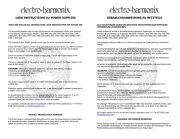
5 Augustus 2025
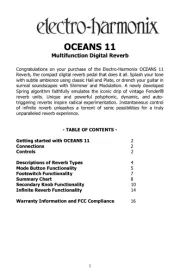
5 Augustus 2025
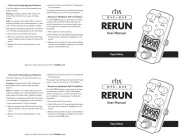
5 Augustus 2025
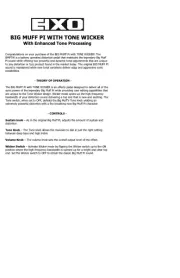
5 Augustus 2025
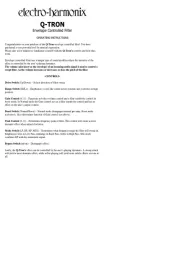
5 Augustus 2025
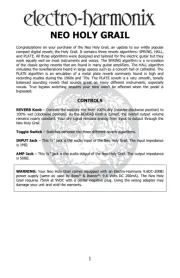
4 Augustus 2025
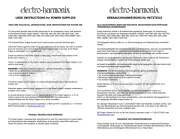
4 Augustus 2025
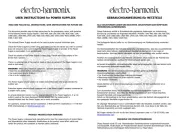
4 Augustus 2025
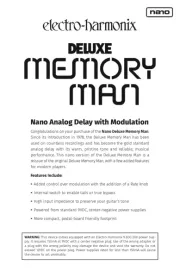
4 Augustus 2025
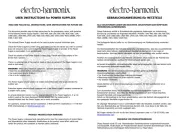
4 Augustus 2025
Handleiding Niet gecategoriseerd
- Squeak
- Tessan
- Livington
- Makita
- Autotek
- Infomir
- Drager
- Microchip
- BBE
- Gourmetmaxx
- Gridbyt
- Proficare
- Cigweld
- Emerio
- Schoeps
Nieuwste handleidingen voor Niet gecategoriseerd

14 September 2025

14 September 2025

13 September 2025

13 September 2025

13 September 2025

13 September 2025

13 September 2025

13 September 2025

13 September 2025

13 September 2025